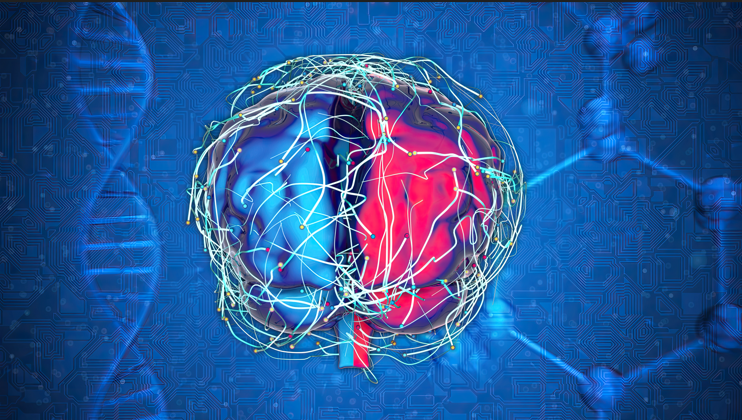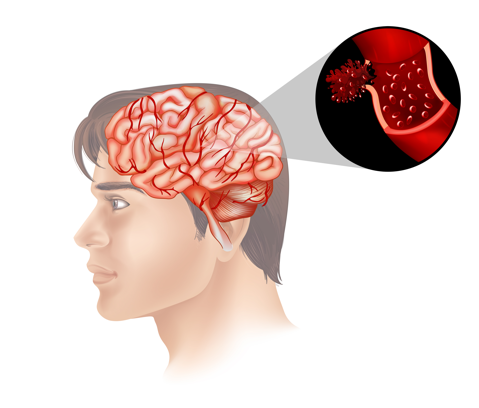
- Ana Sayfa
- Beyin Ve Sinir Cerrahisi
- Apoptosis and necrosis in the circumventricular organs after experimental subarachnoid hemorrhage as detected with annexin...
Apoptosis and necrosis in the circumventricular organs after experimental subarachnoid hemorrhage as detected with annexin...

Apoptosis and necrosis in the circumventricular organs after experimental subarachnoid hemorrhage as detected with annexin V and caspase 3 immunostaining
Objectives: The circumventricular organs (CVOs) are essential for most autonomic and endocrine functions. Trauma and bleeding can affect their function. The aim of this study was to investigate apoptosis and necrosis in CVOs in the early period after experimental subarachnoid hemorrhage (SAH) in rats, using annexin V affinity and caspase 3 immunostaining.
Methods: Three experimental groups were used: Days 1 and 2 after SAH, and a control group, seven Wistar albino rats each. Subarachnoid hemorrhage was accomplished by transclival basilar artery puncture. Rats were perfused with 0.9% NaCl and 0.1M phosphate buffer pH 7.4 until heart stoppage. Apoptosis and necrosis in CVOs were measured by flow cytometry with annexin V staining, and by caspase 3 immunostaining.
Results: Apoptosis in the organum vasculosum lamina terminalis (OVLT), median eminence (ME), and area postrema (AP) was significantly higher in the Day 1 group than in the control group. Apoptosis in the subfornicial organ (SFO), OVLT, ME, and AP was significantly higher in the Day 2 group than in the control group. There were significant differences between the Day 1 and Day 2 groups, except for AP. Necrosis in SFO and OVLT was significantly higher in the Day 2 group than in the Day 1 or control groups, whereas necrosis in the ME and AP did not differ between the three groups. Caspase 3-positive cell density was more intense in the Day 2 group than in the Day 1 and control groups.
Discussion: Prevention of apoptosis may potentially improve impaired functions of CVOs after SAH.
Introduction
Apoptosis is programed cell death, which is altered in pathological conditions such as subarachnoid hemorrhage (SAH).1 Apoptosis is believed to be a contributing factor to the pathogenesis of early brain injury,2 vasospasm,3 andthe brain infarctions4 seen after SAH. In the literature, there are reports of apoptosis1,2,5,6 and necrosis7,8 after SAH, and improvements in these after administration of apoptosis inhibitors.5,6 Studies have demonstrated that inhibition of apoptotic pathways following SAH not only reduced cellular death
but also resulted in a significant improvement in functionaloutcome,2,4 andthusmight havesuppressed many of the secondary injuries associated with SAH.1
Besides many valuable centers of the brain, a number of sensory circumventricular organs (CVOs), such as the subfornicial organ (SFO), organum vasculosum lamina terminalis (OVLT), area postrema (AP), and the median eminence (ME, a secretory CVO), are influenced by **SAH.**9,10 Circumventricular organs are rich in neurotransmitters and are devoid of a blood–brain barrier.11,12
Annexin V has been shown to interact strongly and specifically with phosphatidylserine, and thus can be used to detect early apoptosis.15 Caspase 3 immunostaining is another method currently used to detect apoptosis in tissue samples.16
In this study, we investigated the presence of early and late apoptosis/necrosis by annexin V affinity and caspase 3 immunostaining in CVOs after experimental SAH in rats. In our review of the literature, we failed to find any earlier report dealing with this subject.
Materials and Methods
The study protocol was approved by Bu¨lent Ecevit University Animal Ethics committee.
The experiments were performed at the Experimental Surgery, Research and Animal Laboratory of Bu¨lent Ecevit University, Faculty of Medicine, Zonguldak, Turkey. In total, 21 male adult Wistar albino rats, weighing 200–300 g, were included in the study. All rats were kept at 22–25uC with appropriate humidity, on a 12/12 hours light/dark cycle, and were given fluids and food ad libitum. The rats were divided into three groups as follows: Day 1 after SAH (n 5 7), Day 2 after SAH (n 5 7) and controls (n 5 7).
Rats were anesthetized by intraperitoneal injection of ketamine (60 mg/kg) and xylazine (10 mg/kg). Experimental SAH was accomplished with a technique similar to that described by Barry et al.,17 which has been described previously.9,10
Briefly, a midline cervical incision was made in the supine position, under an operating microscope (Takagi OM-5, Japan), and the clivus was exposed using the anterior parapharyngeal approach. A bony window in front of the basilar artery was created using large-bore needles, taking extreme care not to open the prepontine cistern. A suture needle with an outer diameter of 75 mm (Ethicon, Livingston, UK) was inserted into the basilar artery. Withdrawal of the needle caused extensive hemorrhage into the subarachnoid space, with an even distribution up to the olfactory area. The rats were kept alive for 1 and 2 days after SAH under appropriate conditions.
Rats were euthanized by perfusion. Under anesthesia, thoracotomy was performed, then the left ventricle was cannulated, the descending aorta clamped, the right atrium incised, and the blood washed from the head and cervical regions with 0.9% NaCl and 0.1M phosphate buffer (pH 7.4) until the heart stopped. The animals were decapitated, and specimens of SFO, OVLT, ME, and AP were obtained using a rat stereotaxic atlas (Paxinos & Watson).
The principle of the annexin V method is to measure by flow cytometry the affinity of annexin V to phosphatidylserine, which is translocated from the plasma inner membrane to the outer leaflet during
apoptosis.15 Cells were harvested from the various CVOs separately. We used 100 ml cell suspension for each sample. Annexin V conjugated with fluorescein isothiocyanate **(FITC)-**stained apoptotic cells in the presence of propidium iodide (PI). This reaction enables the detection of phosphatidylserine on the surface of apoptotic cells. Both PI-positive and annexin V-positive cells indicated percentage necrotic status. We used a commercial annexin-FITC kit (Beckman-Coulter, Fullerton, CA, USA) in accordance with the manufacturer’s instructions, and a Coulter FC500 flow cytometer (Beckman-Coulter). A schematic presentation of the loss of membrane lipid asymmetry during early apoptosis and annexin V specific binding to phosphatidylserine is shown in Fig. 1. PI-positive and annexin V-positive cells indicate late apoptosis or necrosis (Fig. 1).
For histopathological and immunohistochemical analysis, CVOs obtained from the rat brains were used for all groups. Circumventricular organs specimens from each rat were fixed in 10% neutral formalin solution, and then embedded in paraffin wax. Sections were cut on a cryostat at 5–6 mm thickness. Tissue sections were then dewaxed and stained with hematoxylin and eosin (H&E) and cresyl violet for histomorphological analysis. Circumventricular organs were evaluated under light microscopy by a single pathologist (FB) blinded to the study groups. Immunohistochemical analysis using the polyclonal antibody anticaspase 3 (CPP32) (Neomarkers, Cat #RB-1197R7, Fremont, CA, USA) was also performed to evaluate apoptosis. Immunostaining was based on the streptavidin biotin peroxidase complex technique with microwave antigen retrieval using formalin-fixed paraffin wax-embedded tissues. Wax-embedded sections were collected onto slides and were then dewaxed and rehydrated. After dewaxing, sections were treated with 10% hydrogen peroxidase in filtered water to block endogenous peroxidase activity. For antigen retrieval, slides were boiled with 10 mmol/L citrate buffer (pH 7) for 10 minutes in a microwave. The slides were then incubated with primary antisera, including caspase 3 rabbit polyclonal antibody (Neomarkers, Cat #RB1197-R7, Fremont, CA, USA). After washing in phosphate-buffered saline, the tissues on the slides were incubated with a biotin-conjugated secondary antibody, followed by incubation in the streptavidin biotin system components for 30 minutes at room temperature. The reactions became visible after immersion of the specimens in 3,39-diaminobenzidine tetrahydrochloride (DAB; Lab Vision, Fremont, CA, USA). Afterward, the sections were counterstained with hematoxylin, then rinsed and mounted. The negative control had the primary antibody omitted, and tonsil tissue was used as the positive control. Caspase 3 immunoreactivity was observed predominantly in the cytoplasm with some nuclear staining. The slides were evaluated in a blinded fashion by a single pathologist (FB). Apoptosis, as measured by caspase 3-positive cell density, was evaluated in the CVOs for each group.
Statistical Analysis
The Statistical Package for Social Sciences (version 19.0; SPSS Inc, Chicago, IL, USA) was used for all data analyses. The results were expressed as median and range. The Shapiro–Wilk test was used for normality testing for variables without normal distribution, and the Kruskal–Wallis test was used for comparisons between the three groups. The Conover test was used for post hoc comparisons. For all statistical comparisons, ,0.05 was considered statistically significant.
Results
Flow-cytometric findings are summarized in Table 1. Graphics obtained from PI/annexin V flow cytometry analysis of the SFO, OVLT, ME, and AP (control and Day 2 groups) are given in Fig. 2. In the Day 1 group, the early apoptosis results, shown as median (range), were as follows: OVLT 0.50% (0.08–1.89), ME 0.55% (0.21–0.84), and AP 0.46% (0.20–1.86), apoptosis in the SFO did not differ significantly from that in the control group. For the Day 2 group, early apoptosis was as follows**: SFO 1.88% (0.97–2.99), OVLT 1.85% (0.77–3.16), ME 0.79% (0.54–1.43), and AP 0.82% (0.19–1.49)**, which was significantly higher in all four areas than in the control group. In the control group, early apoptosis was 0.12% (0.02–0.35) in the SFO, 0.15% (0.04–0.71) in the OVLT, 0.18% (0.09– 0.34) in the ME, and 0.06% (0.01–0.24) in the AP.
Necrosis in the SFO and OVLT in the Day 2 group was significantly higher than in both the Day 1 and the control groups, and the results for the ME and AP did not differ between the Day 1 and the control groups
Histopatological examination of the SFO, OVLT, ME, and AP sections exhibited more prominent cell loss in the Day 2 group than in the other groups.
Caspase 3-positive cell density was more intense in the Day 2 group than in the other two groups. There were few caspase 3-positive cells in the control group, and the Day 1 group had fewer caspase 3-positive cells than the Day 2 group .
Discussion
Apoptosis is one of the mechanisms in the evolution of cell death, which may be seen after clinical and experimental SAH.
In this study of CVOs after experimental SAH, in rats, apoptosis was seen in the SFO, OVLT, AP, and ME. In the Day 1 study group, we found increased annexin V affinity to phosphatidylserine (early apoptosis) in all CVOs except the SFO. In the Day 2 group, apoptosis was significantly increased in all four CVOs compared to the control group and the Day 1 group. Caspase 3-positive cells were more intense in the Day 2 group than in the control group. The probable factors triggering apoptosis at CVOs after SAH are blood clotting and derivatives extravasated to the subarachnoid space or global ischemia, inflammation, oxidative stress, and excitoxicity induced by bleeding.4
SFO: subfornicial organ;
OVLT: organum vasculosum lamina terminalis;
ME: median eminence;
AP: area postrema.
*Difference from control group.
Propidium iodide **(PI)/**annexin V analysis of the SFO, OVLT, ME, and AP (control and Day 2), respectively. The different labeling patterns in this assay identify the different cell populations. Lower left quadrant: vital cells (PI-negative/ annexin V-negative), lower right quadrant: apoptotic cells (PI-negative/annexin V-positive), and upper right quadrant: necrotic cells (PI-positive/annexin V-positive).
The presence of apoptosis is clinically important, as it provides an opportunity to avoid further SAHinduced cell death by using anti-apoptotic agents.1,5,6 After SAH, impaired fluid-electrolyte homeostasis, cardiac abnormalities (especially myocardial ischemia), and abnormal or low secretion of both anterior and posterior pituitary hormones are important clinical problems directly related to the functions of the studied CVOs.18,19 Prevention of apoptosis may potentially improve the impaired functions of CVOs after SAH. This point needs clarification and further research.
Recently, the presence of neural stem cells has been described in CVOs in both human autopsy studies20,21 and in animal studies.22 The presence of neural stem cells in a quiescent state in the CVOs apparently does not significantly prevent the occurrence of apoptosis, and further studies should assess whether injuryinduced neurogenesis in the CVOs correlates with functional recovery.
In this study, we were unable to identify the apoptotic cell types in the CVOs, which is a limitation of the study. Further studies, especially with double immunofluorescence staining, would be helpful to clarify this point.
Using flow cytometry to detect both PI-positive and annexin V-positive cells, we were able to measure late apoptosis or necrosis. Necrosis in the SFO and OVLT was significantly higher in the Day 2 group than in the control group. In a previous study, we compared the ultrastructure of those areas after experimental SAH.10 In this study, transmission electron microscopy (TEM) examinations were performed on day 2 after SAH,10 and we observed findings related to cell ischemia and necrosis in neurons.10 Necrosis was most prominent in the SFO and OVLT.10 Unfortunately, in this study, we were unable to demonstrate apoptotic bodies, although it should be possible in TEM studies to differentiate between apoptosis and necrosis.
Gross reported that the architecture and microcirculation of CVOs were not homogeneous. There were differences in tissue metabolic activity, densities of immunoreactivity for several peptides and amines, cellular sensitivity to neuroactive substances, and afferent neural terminations.24
Morita and Miyata showed that the vascular permeability of low-molecular-mass tracers was higher in the secretory CVO (ME) than in the sensory CVOs
(OVLT, SFO, AP).
Histopathological and immunohistochemical staining of the SFO region for all groups, demonstrated with comparative images for the study groups. Histopathological appearances of the SFO region in tissue sections stained with hematoxylin and eosin (H&E) and cresyl violet for control group (A,B), Day 1 group (E,F), and Day 2 group (I,J) (H&E, cresyl violet; 6100). Immunohistochemical staining intensities using caspase 3 primary antibody (marker of apoptosis) obtained from the control (C,D), Day 1 (G,H), and Day 2 (K,L) groups (bovine serum albumin, DAB).
Increased apoptosis demonstrated with intensive immunohistochemical staining of caspase 3 primary antibody in OVLT (A,B), ME (C,D), and AP (E,F) regions of Day 2 group (bovine serum albumin, DAB).
Extravascular leakage of bioactive and toxic molecules such as ions and peptides may produce damage to parenchymal cells, but the number of neurons is very small in the ME; therefore, such neural damage may not occur in the ME.26
Some investigators emphasized the presence of a dense astrocytic wall in some sensory CVOs,25–27 which is proposed to function as a size-selective barrier in the AP.26,27 Electron microscopy observation using horseradish peroxidase (HRP) showed that the enzyme protein penetrates the inner endothelial basement membrane but not the outer neural basement membrane in the AP.28 These findings indicate the probable factors explaining our finding of the lower necrosis found in the ME and AP than in the SFO and OVLT. In conclusion, our finding of apoptosis in the four CVOs studied needs further evaluation. Future research may clarify whether improvements in the impairment of the functions of CVOs occurring after SAH can be brought about, by the use of antiapoptotic agents.
Disclaimer Statements
Contributors Nurullah Edebali participated, collected, and analyzed data, carried out in vivo experiments, and drafted the manuscript. I˙shak O¨ zel Tekin participated in the design of the study, carried out flow cytometry studies, and collected and analyzed data. Bektas Acikgoz conceived the study, participated in the design of the study, carried out in vivo experiments, and interpreted data and coordination of the study. S¸erefden Ac¸ıkgo¨z collected and analyzed data, drafted the manuscript, and interpreted data. Figen Barut collected and analyzed data and participated and carried out immunostaining tests. Nergis Sevinc¸ participated and carried out flow cytometry tests. Vildan Su¨mbu¨log˘lu participated and carried out statistical analysis. Moreover, all the authors have read and approved the final manuscript.
Funding None.
Conflicts of interest The authors declare no conflict of interest.
Ethics approval The study protocol was approved by Bu¨lent Ecevit University Animal Ethics committee.
Bu makalenin DoktorTakvimi web sitesinde yayımlanması, yazarın açık izniyle yapılmaktadır. Web sitesindeki tüm içerikler, fikri ve sınai mülkiyet mevzuatı kapsamında uygun şekilde korunmaktadır.
DocPlanner Teknoloji A.Ş. web sitesi tıbbi tavsiye sunmaz. Bu sayfanın içeriği, metinler, grafikler, görseller ve diğer materyaller de dahil olmak üzere, yalnızca bilgilendirme amacıyla oluşturulmuştur ve tıbbi tavsiye, teşhis veya tedavinin yerini almak amacı taşımaz. Herhangi bir sağlık sorununuzla ilgili şüpheniz varsa, bir uzmana danışınız.



